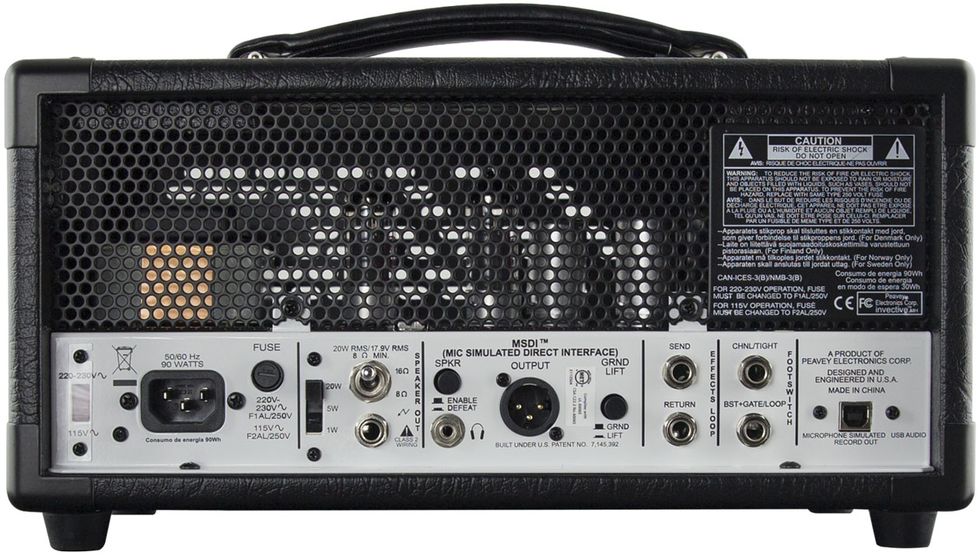RatingsPros:Wide range of mellow-to-monstrous sounds. Useful voice switching and recording options. Cons: No reverb. Street: $699 Peavey Invective.MH peavey.com | Tones: Ease of Use: Build/Design: Value: |
Peavey isn’t new to the mini head game. The 6505 MH and Classic 20 MH already distill the essence of their bigger siblings into compact versions. So, given the popularity of Peavey’s Misha Mansoor signature Invective.120, this Invective.MH version seemed predestined. At just 16.6 pounds, this two-channel, 20W 2xEL84 power tube version is both a high-gain bruiser and easy on the back and bank account.
All in the Family
The Invective.MH borrows several features from its cousins in Peavey’s MH series. One particularly useful feature is the onboard tube status indicator, with two corresponding LEDs, which lets users know if there’s a problem with the power tubes. The LEDs stay green when the amp is on and the tubes are working properly, and light up red when the amp is on standby or if there is an issue with the tubes. There’s also a bias adjustment pot, but there’s no status indicator for the three 12AX7/ECC83 tubes.
The Invective.MH boasts several other very useful MH bells and whistles. The amp is scalable from 20W down to 5W and 1W, and there are a slew of recording options on the rear panel: an MSDI (microphone simulated direct interface) XLR output with a button for speaker enable/defeat, headphone jacks, and a USB jack for direct recording.
The painless USB connectivity alone will be worth the price of admission for some recording guitarists. When I plugged into an ancient MacBook Pro and an older version of GarageBand, the Invective MH connected and performed without a hiccup. The Invective.MH’s built-in cabinet simulation sounded fantastic, and with the speaker defeat button engaged, I was able to record all night without disturbing the neighbors.
Mansoor’s Little Monster
Peavey packed gobs of features into 10 knobs. The clean channel has controls for gain, and low and high EQ frequencies. The lead channel’s controls include gain, low, mid, and high EQ, and post gain. There’s also a master control for resonance and presence, as well as push buttons for channel switching, and gate, tight, and boost functions. (The boost control was created to eliminate the need for a front-end boost or overdrive pedal. When the boost setting is fixed, it is set to the Periphery guitarist’s favorite sweet spot.) The Invective.MH ships with a 2-button footswitch for channel switching and activating the tight function. There’s also a jack for an additional, optional footswitch (not included) to control the effects loop and boost/gate.
Beefy Cleans
I tested the Invective.MH using an ESP M-17 and a Peavey closed-back, Invective.212 cab with Celestion Vintage 30 and Creamback G12H-75 speakers that can be situated vertically or horizontally.
While high gain is clearly the star attraction in the Invective.MH, the clean channel sounds rich and full. With EQ controls at noon, the tone tends toward darkish, with strong but not overpowering bass overtones. At times it reminded me of my old Peavey Classic 50—a cool thing in my book. The clean channel isn’t exclusively dark, though. The EQ controls are powerful, and just nudging low end back to 11 o’clock and high end up to 1 o’clock brightened the tone significantly. You can summon many very pristine and bright clean tones without getting too brittle.
Unlike the 6505 MH and Classic 20 MH, the Invective.MH doesn't have built-in reverb. Initially, I was a little disappointed by the omission. Once I started playing, though, I didn't miss it at all. The cabinet seemed to add enough resonance that the sound still felt very spacious and full. If you need more ambience for clean parts, there’s an effects loop in the back so you can patch in effects with a minimum of noise.

High Gain on the Brain
The lead channel has its roots in Peavey’s 6505 design, and, for leads, it’s pretty hard to beat. With the pre-gain at 1 o’clock and EQ controls hovering around 2 o’clock, notes sustained for almost comically long durations, and single-note lines stayed clear and distinct.
The Invective.MH retains this capacity for detail even in deep detuning situations. I tuned the upper six strings of my 7-string down a half-step and then the low B string down to Ab, and played rhythm parts from Mansoor and Periphery’s “Make Total Destroy.” Impressively, the lowest notes were articulate and note response felt super fast. I also maxed the gain and played rhythm patterns with Holdsworth-style cluster voicings. The notes of these dissonant sonorities all rang true, which was pretty surprising considering how much gain I had slathered on.
Where the full-size Invective.120 is a three-channel design with clean, lead, and crunch, the Invective.MH has just two. In lieu of a crunch channel, the Invective.MH features a tight button, which reduces gain slightly and bumps the high mids. It’s an effective stand-in, and useful for playing distorted, single-note, arpeggiated, and melodic rhythm parts.
The Invective.MH’s built-in noise gate is also a smart addition and essential for playing modern metal styles. If you’re using a lot of gain, there’s almost no way to get staccato figures to sound clean and crisp without activating a noise gate of some kind, so its inclusion is a big plus.
The Verdict
If you’re into Misha Mansoor and modern metal, the Invective.MH is a no-brainer, must-check-out amp. But it’s also surprisingly versatile, and whether onstage, in the bedroom, or the studio, just about any guitarist could find a use for this monstrous-to-mellow amp. The wallet friendly $699 price tag just makes the deal that much sweeter.
Watch the First Look:









![Rig Rundown: Russian Circles’ Mike Sullivan [2025]](https://www.premierguitar.com/media-library/youtube.jpg?id=62303631&width=1245&height=700&quality=70&coordinates=0%2C0%2C0%2C0)

















